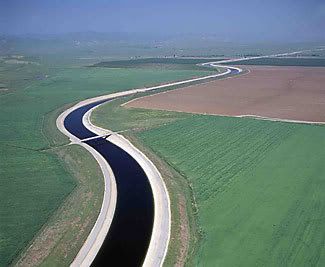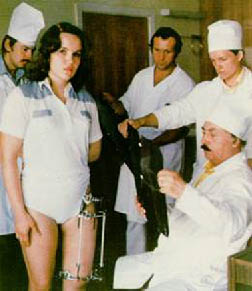H20

California Aqueduct, The Central Valley
Dorothy Green's Final Fight: Before She Died, Heal the Bay Founder Said California's Drought Is a Fake
"If we managed water differently — better — there would be plenty of water for the state of California."
Judith Lewis, LA Weekly, 10/16/08
I didn’t go to talk to Dorothy Green because she was dying. I wasn’t looking to do a tribute. I went because I was working up a story about water, about how we use it and abuse it, mismanage it and waste it, and about how the bipartisan water bond being pushed by Governor Arnold Schwarzenegger and Senator Dianne Feinstein — with its provisions for new dams and “water conveyance” projects — is a really bad idea. In August, I had gone to a protest rally against the water bond at which Green had spoken, and in the brief interview we had that day, I realized how much of my thinking about water — about Southern California’s wasted storm water, the Central Valley’s reckless and polluting agricultural irrigation, the rage that simmers up in me when people call storm drains “sewers” and dump crap into them —traced back to Green. I had never sat down and talked to her. She gave me her card and told me to call.
Her pauses were mitigated by the urgency of her message, by the sense she had that this was her last chance to save the declining species of the California Delta, including the smelt and salmon, and to put right more than a century of corruption that had robbed California’s citizens of their right to clean, safe water — to drink, to water their gardens, to swim in.
And she was still trying to persuade California’s lawmakers and citizens that “Big Ag,” as she called it, had spent the past century pulling a fast one on the public. At the time of the Reclamation Act, “a family farm was 160 acres,” Green explained. “The Central Valley clearly does not have family farms. And yet they exist on water subsidized by the state. It’s a huge scandal.” As she explains in her 2007 book, Managing Water: Avoiding Crisis in California,the limit was later raised to 960 acres. “But before that, they played a lot of interesting games, setting up farms to make them look like family farms, when they were actually corporations.
“What we want to find out now is who really owns the farms in the Westlands Water District, which is the largest water district in the nation. Nobody has really taken a look at this business of Big Ag, of all these corporations. Who are the real owners? How many owners are there, really, of this subsidized water?”
Which doesn’t mean backing off from the truth. Reading Managing Water, especially its fifth chapter, on state water policy, is like slowly peeling off the veneer of a great mythology: that California is America’s “bread basket” and must always stay that way. California does produce half the country’s fruits, nuts and vegetables, but “it’s not the economic engine of the state,” Green insisted. “It’s only 3 percent of the economy.” According to the Environmental Working Group, 10 percent of the farms get 67 percent of the state’s water. And 80 percent of the state’s entire water supply is used for crops — mostly low-value, irrigation-intensive crops like cotton. “Let the Chinese grow cotton!” she quotes cotton magnate J.G. Boswell out of Rick Wartzman and Mark Arax’s King of California,predicting there wouldn’t be any cotton grown in California 10 years from now.
That fifth chapter “is really about how Big Ag has really taken over water politics,” Green confirmed. It’s also about how big agricultural corporations in California are losing interest in the increasingly unprofitable business of farming, as Boswell himself predicted. “Big Ag is interested instead in getting control of the water supply in order to market the water and turn it into a commodity,” Green asserted. “And you do that by creating a drought, so that you can pin down water rights. You do that by inventing a disaster, and get the governor to create a water-rights shortage.
Environmentalists won that battle to stop the Peripheral Canal, and so it was with palpable dismay that Green, in her final months, saw the plan resurface, in carefully coded language, in Schwarzenegger and Feinstein’s water bond. Now tentatively slated for an April ballot, the measure was ostensibly drawn up to confront the historic drought plaguing California farmers. Green acknowledged there might be less water than usual: Eight years of decreased snowfall has starved the Colorado River, which supplies 60 percent of Southern California’s water, most of which goes to the Imperial Valley Irrigation District. Reduced precipitation in the mountains and an early-melting Sierra snowpack have all depleted the state’s reservoirs. But Green insists that were it not for irrational pressure on the water supply due to mismanagement, there wouldn’t be a problem.
“For the last five years, they’ve pumped the Delta dry because the Metropolitan Water District built [the Riverside County reservoir] Diamond Valley Lake and that had to be filled, and the Kern Water Bank [in Kern County] was pumping like crazy. So you’ve got these normal rainfall years, or a little bit below normal rainfall, but if you’re going to fill Diamond Valley Lake and the Kern Water Bank, then you have a real shortfall.” Westlands Water District now has a contract for 1 million acre-feet of water a year — more than 300 billion gallons, as much water as 2 million Los Angeles households use in a year. The Kern Water Bank was recently caught buying up subsidized state water at $28 per acre-foot and selling it back to the public for 10 times the cost. Along with water from Westlands, water from Kern gets poured onto arid soil that many argue should never have been irrigated. The water releases toxic selenium into groundwater, polluting rivers and eroding land with runoff.
“Their water rights ought to be taken away, their land taken out of production and their operations shut down,” Green said.
I could hear the cries of protest as she spoke — what about all those jobs? “California’s farming communities are the most poverty-stricken in the state,” Green said. “The profits, the benefits, go to Stewart Resnick. He’s the biggest farmer in the state — he owns Paramount Farms — and he lives in Beverly Hills.”
Before reading Judth Lewis' article, I'd always assumed California, especially southern California, was in a drought. I'm not entirely convinced we aren't but I want to know more. I think I'll check out Dorothy Green's book, Managing Water Avoiding Crisis in California.
Labels: Earth Mama


1 Comments:
I was a long-time friend of Dorothy Green and was also on the staff against the peripheral canal in 1982. I am glad to see her fight for honest water has reached the LA Weekly. All said is true. For even more, go to my blog, http://watergrab.blogspot.com and you can read the whole history of the war for the peripheral canal.
Burt Wilson
Post a Comment
<< Home